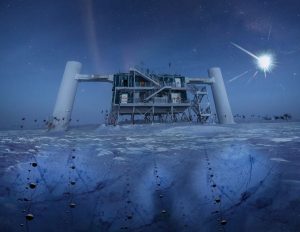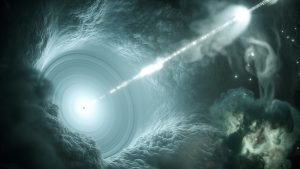Ghost particle from space
 For the first time, an elusive ghost particle blasted from deep space is seen on Earth
For the first time, an elusive ghost particle blasted from deep space is seen on Earth
BY MARK KAUFMAN From Mashable
Billions of years ago, a supermassive black hole feeding on gas and dust in the center of a galaxy spit out a subatomic ghost.
That ghost particle — known as a neutrino — has quietly made its journey through the cosmos, across billions of light-years and arrived on Earth, where a large group of neutrino-hunting scientists were waiting to see it.
A giant detector located in Antarctica caught sight of the neutrino sent into space by that feeding black hole, known as a blazar, marking the first detection of its kind in history. The groundbreaking new finding is detailed in two papers published in the journal Science Thursday.
Though scientists have detected the elusive particles on Earth, this detection marks the first time researchers have seen a neutrino that came to our world specifically from a powerful deep space source.
Scientists have a compelling reason to call neutrinos “ghost particles.”
“They can travel through anything and only make their presence felt when they want to,” Lindley Winslow, an MIT physicist that researches these mysterious particles, said in an interview.
“10 billion neutrinos a second pass through your thumb,” Darren Grant, a neutrino physicist at the University of Alberta, said, but you can’t feel them.
“Their behavior is very much how people imagine a ghost — it doesn’t leave any trace that it was there,” Grant added.
Scientists like Winslow and Grant suspected that highly-energized forms of these elusive particles, smaller than an atom, might be created by powerful forces in the distant cosmos and then thrown into space. But, although the particles are all around us — said Grant — they’re incredibly difficult to detect.
But now, the hunt for neutrinos is paying off.
The ghost particle seen in the South Pole passed through a giant neutrino detector aptly named IceCube: It’s a one-kilometer cube of ice some 2,500 meters (8,200 feet) under Antartica that has been outfitted with over 5,000 detection tubes. The idea was to build a massive detector, and hope that a deep space neutrino would eventually both collide with the sizeable icy instrument, and also make itself known.
“We knew that these particles had to be coming from somewhere,” said Winslow, who was not involved with this research. “The question was where. Now we know.”
For years, scientists have measured blasts of powerful energy from the deep cosmos, called galactic cosmic rays, hitting Earth’s atmosphere.
They assumed that something powerful in deep space was producing both these rays, and probably these highly-charged ghost particles, too.
It now appears this is the case, and a distance blazar is responsible, Josh Frieman, a physicist at the Department of Energy’s Fermi National Accelerator Laboratory who had no study involvement, said over email.
Grant, a coauthor of the research, called the discovery nearly akin to scientists first seeing remnants of the Big Bang, when the universe was created, or the more recent detections of gravitational waves, ripples in time and space traversing the solar system.
“Those of us that like neutrinos are pretty excited,” said Winslow.
“It’s the infancy of a new field,” noted Grant.
Why finding ghost particles matter
Much of our view and understanding of the universe comes from seeing light, said Winslow.
Some of this includes things we can observe directly, like far-off galaxies. Another, new tool is the ability to detect gravitational waves, and then infer what powerful event could have created such momentous energy.
And now, there’s a third: neutrinos.
“It’s a whole other sense,” said Winslow.
“We’ve proven that neutrons are that third tool — to better understand the wonderful and weird things that are out there.”
And one these weird things is most certainly blazars: As gas and dust fall into a massive black hole at the center of a galaxy, they shoot some of this matter outwards, where it speeds out of both sides of the black hole in two vigorous jets.
And sometimes, these jets happened to be aimed at Earth — or Earth happens to pass through one of these jets. When the neutrinos in those jets make it to our planet — and we’re fortunate to detect one — they can help us understand what’s out there in the void.
An artist’s rendering of a rather energetic blazar.
“You can imagine being able to measure activities of the most violent processes of the universe in the neutrinos themselves,” said Grant.
The elusive particles only show themselves when there’s another small particle quite close by, allowing them to interact with that particle. “That doesn’t happen very often,” said Grant.
“If you live to be 80, one neutrino may interact with your body during your lifetime,” he added.
But when a detector does pick one up, scientists can then use traditional telescopes (which measure different types of light radiation) to peer back into space at the source — just like they did after detecting this neutrino. This allows them to confirm what’s likely out there.
In this case, it was a supermassive black hole, ejecting jets of energy. And once this blazar blasted out this neutrino, it traveled directly to our solar system, unperturbed by the powerful gravitational energies in space that bend light and distort energy.
“The neutrino doesn’t suffer from that,” said Grant. “It travels unhindered from its source.”
It passes through turbulent space, then, just like a ghost passing calmly through bedroom walls.
IMAGES:
An artist’s rendering of a rather energetic blazar. IMAGE: NASA
An artist’s rendering of the IceCube lab, as an energy source approaches in the South Pole sky.
IMAGE: ICECUBE/NSF Artist’s illustration of a blazar. IMAGE: DESY, SCIENCE COMMUNICATION LAB
For more on this story go to; https://mashable.com/2018/07/12/neutrino-detection-ghost-particle-antarctica/?utm_cid=hp-hh-pri#Xg8ARhsuHkqj







